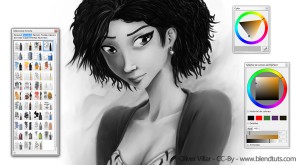MyPaint is an open source and free to use natural painting application similar to Painter. It’s really good, but unfortunately there isn’t a native port to the Mac. No fears, thanks to Wineskin it’s trivial to use it on your Macintosh. I created an easy to follow instruction to walk you through the process of created a Wine wrapper so you can run MyPaint on OS X, download it here. You could probably use this walk through with any Windows software that works well in Wine.
If you’re more interested in a faster more stable MyPaint and don’t mind getting your hands dirty, and you have plenty of drive space, go the Macports route – it’s really easy. I found this to be a better alternative to Wine. This guide is for Mountain Lion, but should work on previous versions. Not sure about 10.5 or lower though…
The first thing you need is XCode 4.4, which is free from the AppStore. Once XCode is installed open XCode and go into Preferences, Downloads tab and install the Command Line Tools.
Mountain Lion no longer includes x11 so you will need to download and install XQuartz. This is free also. Once that is finished download and install Macports.
Fire up the Terminal, which is in ‘/Applications/Utilities’.
Type the following to install a more Mac like theme for the program window:
sudo port install gtk-theme-switch
Go get some coffee and a sandwich… Once finished install the theme:
sudo port install gtk2-aurora
Once it’s finished type: switch2
Select Aurora if it’s not already selected.
Now it’s time to install MyPaint, type:
sudo port install mypaint
Go take a nice nap… When you wake up hopefully it’s finished loading and compiling everything including MyPaint.
To run MyPaint simply go into /Applications/Macports and click on MyPaint like any other Mac app.
So what’s this Macports stuff anyway? Macports allows you to run Linux software on the Mac. It manages software dependencies and all the hard stuff like compiling everything. If you are familiar with Linux then you’ll likely compare it to Apt or Yum package managers. If you’re worried what it has done under the hood don’t worry too much. It installs the majority of files in /opt keeping it fairly separated from the Mac file system. To uninstall you can simply delete the Macports files. A command to do this can be found here.
Enjoy


